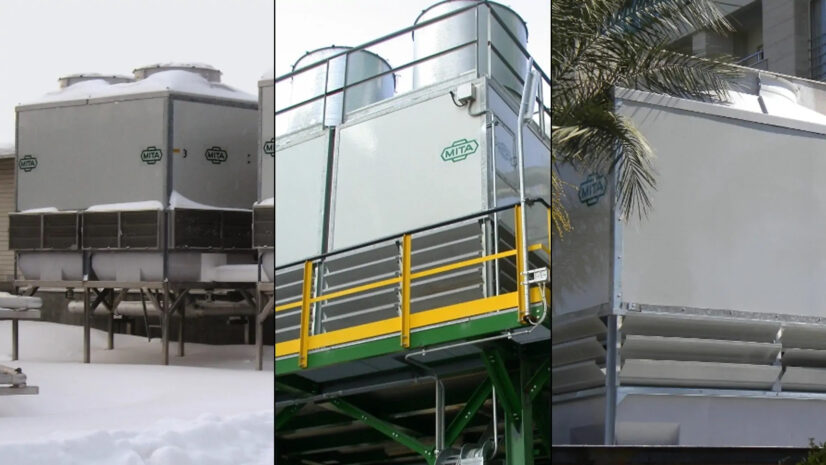Fibreglass cooling towers: why are they still up-to-date?

Many manufacturers of open and closed circuit cooling towers, even large ones, continue to use fibreglass to manufacture various kinds of components, and even structural profiles as in the case of field erected cooling towers.
One wonders what the reasons for such a choice might be: why are fibreglass cooling towers still up-to-date? It should be noted that the composite material in question is much more expensive than sheet metal. Moreover, for the construction of the machine’s “body parts” and special pultruded profiles, it involves considerable investment in terms of manufacturing equipment.
Moreover, a construction that, for example, is built using press-formed and perforated sheet metal panels is undoubtedly more easily standardized and more straightforward than one that involves preparing a set of moulds to manufacture dedicated fibreglass components. These also generally require an aesthetic finish similar to that of automotive bodywork or furniture components.
So… what’s the reason?
—
by Giorgio Lorenzetti – Technical Advisor
Advantages of fibreglass in evaporative cooling towers
The answer is simple in essence, but this conclusion has been reached thanks to a number of prior technical considerations and assessments that require a profound knowledge of manufacturing technology: when in constant contact with water, fibreglass does not oxidise, it does not rust, it is unchanged over time, is not affected by the weather and is therefore maintenance-free. It is also lighter than steel and, if accidentally damaged, can be easily repaired to an ‘as new’ condition.
The structural sturdiness of moulded components is obtained thanks to a successive layering of glass fabric called a “mat”, which is then soaked in resin. Once catalysed, the resin and the various mat layers are fused together into one body. The result is a structurally robust piece with a uniform and continuous surface.
External protection is achieved by applying UV-resistant gelcoat directly in the mould, while the inside is waterproofed by applying a gelcoat with a paraffin additive that entirely prevents osmosis.
For the more complex and fragile pieces, particular attention is paid to the orientation of the glass fibres, so that they can better withstand and distribute the static and dynamic loads to which the pieces are subjected.
Ask for more info about fibreglass cooling towersFibreglass and pultruded profiles
Pultruded structural profiles on the other hand are produced using a dedicated die according to the design of the profile itself. In this case the catalysed resin mixture is blended with the glass fibre upstream of the casting process. A special feature of pultruded profiles is the use of continuous-filament fibreglass to ensure that the profile has the mechanical and structural resistance that is generally required of this type of product.
Pultruded profiles can also be protected against UV radiation and the risk of water osmosis.
So why build fibreglass cooling towers? Conclusions
So why then do some manufacturers, including MITA Cooling Technologies and TORRAVAL Cooling, the Group’s Spanish subsidiary, always prefer this technology over other less expensive ones?
Even if the answer seems obvious, the reason is not one of convenience for its own sake: it is linked to the decision to market a superior quality product. The goal is to reduce, if not completely eradicate any corrosion problems and the resulting maintenance the user would be required to make allowances for.
Though undeniably involving a greater cost, the use of fibreglass components give customers greater “flexibility” even in the presence of chemically aggressive waters, while the standard design ensures that the price is still competitive.
Ask for more info about our cooling technologiesResources
Best practices
Read all Pieces of Advice by MITA Cooling TechnologiesWhat to Know
Find Out All Technical TermsTechnical Articles
Read All our Technical ArticlesNewsletter
Subscribe to MITA newsletter and stay updated on technical solutions for industrial and civil cooling and get to know our offer.